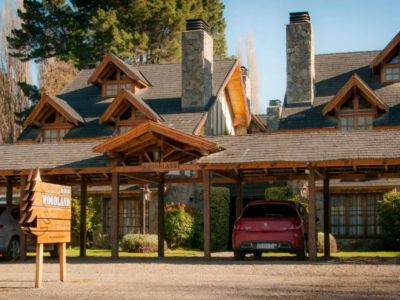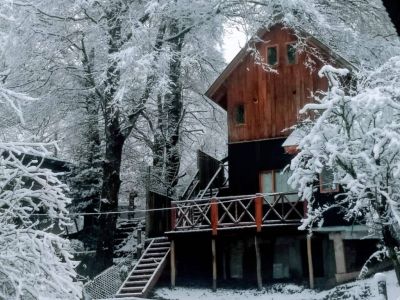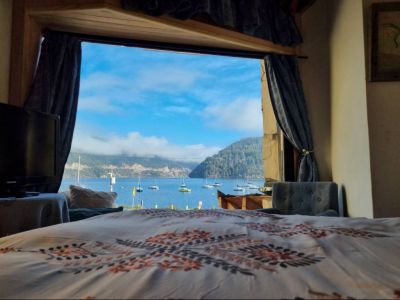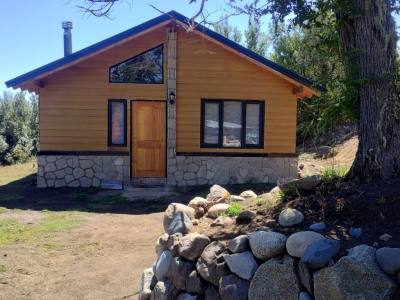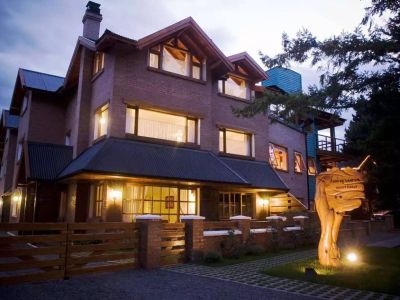The Cities of San Martín de los Andes and Junín de los Andes are the heads of this circuit in which the Mamuil Malal International Pass leads to Chile. Its winding quiet roads laid out amidst the vegetation, rivers and lakes of extreme beauty make this a popular choice among tourists. The Chimehuín River bade us farewell at Junín de los Andes. As we reached the Province of Neuquén rural police station, we took paved Provincial Route 23 and were surprised by its undulations and the animals grazing free in its fields. Afterwards, we crossed the Malleo River and Provincial Route 60 led us to the border, always in the company of that excellent fishing environment. As we entered Lanín National Park, we were impressed by the presence of an ancient monkey-puzzle tree woodland area and the immense silhouette of the Lanín Volcano to our left.
The Mamuil Malal Pass
We got off the car to stretch our legs and record that moment with our camera. In the meantime, the wind reminded us that we were in Patagonia. From that point onwards, the presence of Gendarmería Nacional (the corps of border guards), the park ranger station and the border post followed one another and we carried out all the necessary proceedings to leave the country bearing the corresponding documents. A few meters away from the Chilean milestone, we found the Chilean customs office and the Carabiners’ station, where a strict control is executed to check that vegetable, animal or fresh foods products forbidden by the authorities of the of the Servicio Agrícola Ganadero (SAG) (Agricultural and Livestock Service) do not enter the country. We started to travel across Chilean territory along a gravel road for about 30 kilometers and we soon spotted Lake Quillelhue to our right. From a viewpoint on one of the bends, we could see a cascade falling into the lake. From that point onwards, the vegetation became thicker, featuring a great diversity of species due to the high rainfall regime throughout most of the year. As we reached Puesco, where the old Chilean customs was, the pavement made us smile and escorted us to our destination. We made a stop in Curarrehue to get to see the town and have lunch at one of the restaurants serving homemade food: a family atmosphere and good assistance. We also got some fuel supply to go onto Pucón. That area is famous for its excellent thermal waters. Countless springs provide high temperature waters with healing and relaxing properties. For such reason, several hot spring resorts offer outdoor or screened pools and hot tub baths. We were given accommodation and gastronomy brochures at the tourist office. Surrounded by forests and lush vegetation, as well as making contact with nature, there is the possibility to go hiking and on tours that complete the stay. All along this stretch, we paid attention to the side paths so as to spot the accesses to San Luis, Menetúe and Huife hot spring resorts, for example, and bear them in mind as a destination for a future relaxing trip. Catripulli was the next town. Lying on the Trancura River, which runs between steep walls at some locations, it is a simple and typical village in the Chilean provinces where the smoke of the chimneys gives life to each wooden house we saw on the way. We reached Pucón with the feeling of having had a very pleasant journey. The good pavement prevailed over the gravel stretches, which do not surpass 40 kilometers all in all, considering both the Argentinian and the Chilean sides. This is an ideal road to slow down and enjoy the vehicle as well as the scenery.
Mónica Pons
Eduardo Epifanio
Contact of the excursion or tour
Aduana
Caupolicán esquina B. O´Higgins, Pucón, Pucón, IX Región, Chile
Phone: +56 41-2857746
Aduana
General Roca y Rodhe, San Martín de los Andes, Neuquén, Argentina
Phone: +54 2972-42-7273
The Argentinian and Chilean Customs Office coordinate their operations and are open from 8am to 8pm year round. Chile changes its time zone during the winter. Therefore, before setting out, it is advisable to check the open hours at the tourist office.


















